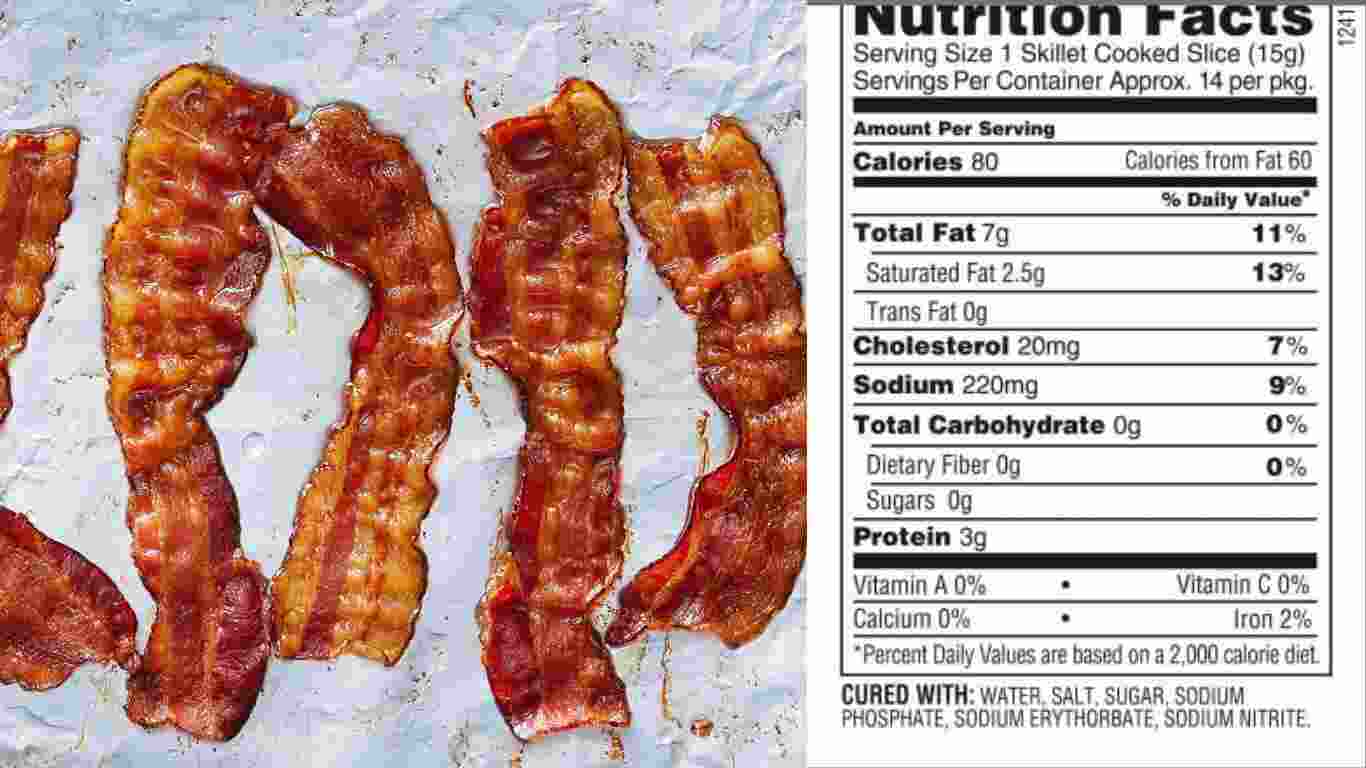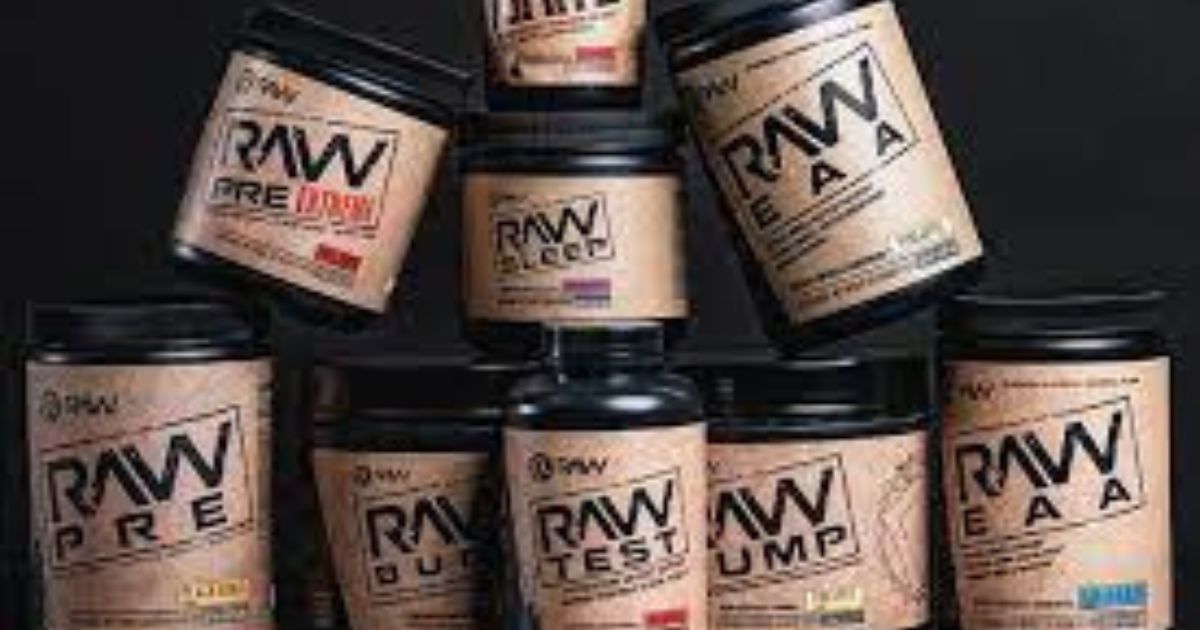One slice of bacon contains about 42 calories, 3 grams of fat, and 3 grams of protein. Bacon is not particularly rich in nutrients, but it can be a flavorful addition to many dishes.
Bacon is a popular food that is used to flavor and add texture to a wide range of dishes. It is often used in breakfast dishes like scrambled eggs, pancakes, and waffles. Bacon can also be used in sandwiches, salads, and as a topping for burgers and pizza.
While bacon is delicious, it is not particularly nutritious. One slice of bacon contains about 42 calories, 3 grams of fat, and 3 grams of protein. It is also high in sodium and cholesterol, so it should be consumed in moderation. Despite its nutritional limitations, bacon remains a popular and tasty food that many people enjoy.

Nutritional Facts Of Bacon
We all love the smell of bacon sizzling on the pan and the taste of crispy bacon. But have you ever wondered about its nutritional content? Bacon is delicious but contains high saturated fat level. In this section, we’ll discuss the nutritional facts of bacon per slice to help you make informed choices.
Fat Content In Bacon
Bacon is high in fat, and most of the fat is saturated fat. A slice of bacon (approximately 12-14 grams) contains around 3. 5 grams of fat, which is approximately 14% of the daily value (dv) for fat. Half of this fat is saturated fat, with around 1.
5 grams of saturated fat per slice. While bacon can be a part of a balanced diet, it is important to consume it in moderation.
- One slice of bacon contains 14% dv of fat
- Half of the fat content in bacon is saturated fat
Calories In Bacon
Bacon is a high-calorie food and is not recommended for those on a low-calorie diet. A slice of bacon contains around 43 calories. Although these calories are not bad in moderation, too much bacon can lead to excess calorie intake.
- One slice of bacon contains approximately 43 calories.
Protein In Bacon
Bacon is a meat product and as such contains protein. A slice of bacon contains around 3 grams of protein, which is approximately 6% of the dv for protein. While bacon is not an excellent source of protein, it can add some amount of daily protein intake to a person’s diet.
- A slice of bacon contains around 3 grams of protein
- It is approximately 6% of the dv for protein.
Vitamins And Minerals In Bacon
In addition to being high in fat, bacon has some essential vitamins and minerals. One slice of bacon contains small amounts of some essential vitamins and minerals such as:
- 5.8 mg of cholesterol
- 8 mcg of folate
- 0.3 mg of iron
Although these values may not seem significant, consuming bacon in moderation while eating other nutrient-dense foods can help individuals meet several key nutrients’ daily values.
While bacon may not be the healthiest food choice to consume frequently, those who love the taste of bacon can still enjoy it in moderation. One slice of bacon can add a lot of flavor to certain dishes while providing some protein and essential vitamins and minerals.
Just remember to keep track of your calorie and fat intake to avoid health complications.
Is Bacon Healthy?
Bacon Nutrition Facts Per Slice
Bacon is undoubtedly one of the most popular breakfast foods worldwide, and its consumption is a long-standing tradition in many households. However, bacon’s nutritional value has been the cause of endless debates among health enthusiasts and breakfast lovers. So, is bacon healthy?
In this post, we will delve deep into the pros and cons of consuming bacon and its impact on our cholesterol levels, amount of sodium, and the importance of moderation.
Pros And Cons Of Consuming Bacon
Although bacon is a delicious treat, it is not the most wholesome food. There are both pros and cons to consuming bacon, which we will outline below:
Pros
- Bacon is rich in protein, with one slice containing approximately 3g of protein.
- Bacon contains essential vitamins, such as vitamin b12, which helps support our nervous system.
- Bacon contains choline, a nutrient that plays a vital role in maintaining cognitive performance and brain health.
Cons
- Bacon is high in saturated fat and calories, which can lead to weight gain and increase the risk of heart disease.
- Studies have shown that processed meats, including bacon, are associated with an increased risk of cancer.
- Bacon is high in sodium, which can lead to high blood pressure, a major risk factor for heart disease and stroke.
The Impact Of Bacon On Cholesterol Levels
Bacon is high in cholesterol, with one slice containing approximately 10% of our recommended intake. The good news is that studies have shown that eating foods high in dietary cholesterol does not significantly impact our cholesterol levels. However, it’s essential to note that consuming bacon in excess, along with other high-cholesterol foods, can lead to a buildup of plaque in our arteries, increasing the risk of heart disease.
The Amount Of Sodium In Bacon
Bacon is high in sodium, with one slice containing approximately 190mg of sodium, which is approximately 8% of our daily recommended intake. Consuming too much sodium can increase blood pressure and increase the risk of stroke, heart disease, and other health problems.
It’s crucial to limit our overall daily sodium intake to less than 2,300 mg per day and ensure moderation when consuming high-sodium foods like bacon.
The Importance Of Moderation
While consuming bacon has its benefits, it’s essential to consume it in moderation. A healthy diet is all about balance and ensuring that we’re getting all the nutrients our bodies need while maintaining a healthy weight. Here are a few tips for consuming bacon in moderation:
- Limit your bacon consumption to a few slices per week.
- Choose low-sodium bacon or cut back on the additional salt added to the bacon while cooking.
- Pair your bacon with veggies or fruits to create a balanced breakfast meal.
Bacon can be part of a healthy diet if consumed in moderation. While it is high in cholesterol and sodium, it also contains protein and essential vitamins. Ultimately, it’s about finding balance and ensuring that we’re making informed and healthy food choices.
Choosing The Right Bacon
Different Types Of Bacon
Bacon is a popular pork product that comes in different types. Here are some of the most common types of bacon:
- American bacon: This type of bacon is sliced from the pork belly and is usually smoked. It’s typically salty and fatty, with a crispy texture when cooked.
- Canadian bacon: Also known as peameal bacon, this type of bacon is made from cured pork loin. It’s typically leaner than american bacon and has a round shape.
- Pancetta: This italian bacon is made from pork belly that is heavily seasoned with salt, pepper, and other herbs. It’s typically not smoked and has a chewy texture when cooked.
Nitrate-Free Bacon
Nitrate is a chemical used in some types of bacon to preserve color and prevent bacterial growth. However, some people prefer to avoid nitrates due to health concerns. Nitrate-free bacon is bacon that doesn’t contain any added nitrates or nitrites.
Here are some key points about nitrate-free bacon:
- Nitrate-free bacon is usually made from pork that has been raised without antibiotics and hormones.
- Nitrate-free bacon is often more expensive than traditional bacon.
- Nitrate-free bacon can be found in most grocery stores, either in the meat section or in the health foods section.
Organic Bacon
Organic bacon is bacon that is made from pork that has been raised according to organic farming standards. This means that the pigs are raised without the use of antibiotics, hormones, or genetically modified feed. Here are some key points about organic bacon:
- Organic bacon is usually more expensive than traditional bacon due to the higher cost of organic farming practices.
- Organic bacon is often sold in specialty stores or online, rather than in traditional grocery stores.
- Organic bacon can be found in different varieties, including nitrate-free and heritage breeds.
Comparison Of Different Bacon Options
When choosing the right bacon for you, it’s important to consider the different options available. Here is a comparison of the different bacon options:
- American bacon: This bacon is the most popular and widely available option. It’s typically affordable and has a salty, fatty flavor. However, it’s also high in calories and sodium.
- Canadian bacon: This bacon is leaner and lower in calories and fat than american bacon. It’s a good option if you prefer a milder flavor.
- Pancetta: This bacon is often used in italian cuisine and has a strong, savory flavor. It’s not as readily available as other types of bacon and is often more expensive.
- Nitrate-free bacon: This bacon is a good option if you’re concerned about the health effects of nitrates. However, it’s often more expensive than traditional bacon.
- Organic bacon: This bacon is a good option if you’re concerned about the environment and animal welfare. It’s usually more expensive than traditional bacon but may be worth the extra cost if you value organic farming practices.
Choosing the right bacon depends on your personal preferences and dietary needs. Consider the different options available and choose a bacon that fits your tastes and values.
Cooking Bacon
Methods Of Cooking Bacon
Bacon is one of the most versatile ingredients in the kitchen as it can be cooked using various methods. Each approach results in a slightly different texture and flavor. Below are some popular methods of cooking bacon:
- Pan-frying: This is the most common way of cooking bacon in which slices of bacon are laid out in a hot skillet and cooked until crispy. It’s simple and quick and can be done on the stovetop.
- Baking: To bake bacon, arrange the slices on a baking sheet and bake in the oven until they’re crispy and golden. This method is great for cooking a large amount of bacon at once.
- Grilling: Grilled bacon is often used in sandwiches and burgers. To grill bacon, lay slices across a grill grate and cook until crispy.
Differences Between Cooking Methods
Each of the above methods also has their own differences, and you should choose the right one depending on the desired outcome.
- Pan-frying: When pan-frying, you can achieve crispy bacon with slightly chewy texture, or you can cook bacon for a shorter time to have more tender slices.
- Baking: Baking allows bacon slices to cook more evenly without any flipping and helps them to retain their shape. The texture is delicate and the flavor is slightly smoky, with a crispy exterior.
- Grilling: Grilled bacon has a slightly smoky flavor with grill marks adding aesthetic appeal. Plus, grilling is an excellent option for cooking bacon during warm weather or cookouts.
Recommendations For Cooking Bacon
Regardless of the technique you choose for cooking bacon, the following tips will help you achieve the best results:
- Start with a cold pan or oven, so the bacon gradually cooks and renders its fat without burning on the outside.
- Turn the bacon frequently to ensure even cooking and to avoid burning.
- Drain the bacon on a paper towel before serving to remove excess grease and to make it crispy.
- Experiment with different types of bacon, such as thick-cut or slab bacon, to find your preferred flavor and texture.
Enjoy your delicious and perfectly cooked bacon with your favorite breakfast items such as eggs, toast, and pancakes.
Frequently Asked Questions Of Bacon Nutrition Facts Per Slice
What Are The Nutritional Facts Of Bacon?
One slice of bacon has approximately 45 calories, 3g of fat, 0g of carbohydrates, and 3g of protein. Bacon is also high in sodium and saturated fat.
How Many Calories Are In A Slice Of Bacon?
One slice of cooked bacon has around 45 calories.
What Nutrients Can You Get From Eating Bacon?
Bacon is a good source of protein, iron, and vitamin b12.
Is Bacon Bad For Your Health?
Eating too much bacon can negatively impact your health due to its high sodium and saturated fat content, which can lead to heart disease and high blood pressure. Moderation is key.
How Much Bacon Is Safe To Eat?
Due to the health concerns associated with bacon, it’s best to enjoy it in moderation. A few slices a week can be fine, but it’s important to balance your diet with plenty of fruits, vegetables, and other sources of protein.
Conclusion
Looking at the facts surrounding bacon nutrition per slice, it’s clear that moderation is key. While bacon is a tasty addition to many dishes, it’s important not to go overboard and consume it in excess. By doing so, you could run the risk of consuming unhealthy amounts of sodium, cholesterol, and saturated fat.
On the other hand, when consumed in moderation, bacon can be a good source of protein and other essential nutrients that can benefit your overall health. Therefore, it’s up to you to decide how much bacon is right for your diet.
Always remember to balance your consumption of bacon with a variety of other healthy foods – that way, you can enjoy all the deliciousness that bacon has to offer without compromising your health in the process.




